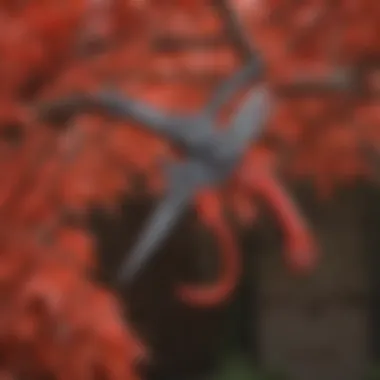Mastering Pruning Techniques for Japanese Red Maple Trees: A Comprehensive Guide


Gardening Techniques for Japanese Red Maple Trees
Japanese red maple trees are a stunning addition to any garden, their delicate leaves adding an elegant touch to the landscape. Pruning these trees is an art that requires precision and skill to ensure optimal growth and aesthetics. Understanding the importance of pruning is paramount in caring for your Japanese red maple tree.
Key Aspects of Pruning Techniques
- Timing: Pruning Japanese red maple trees should ideally be done during dormancy in late winter or early spring to prevent sap bleeding, ensuring the tree's health.
- Tools: Sharp and clean pruning tools such as bypass pruners are essential to make clean cuts without causing damage to the tree.
- Techniques: Utilize pruning techniques such as thinning cuts to remove excess branches, heading cuts to encourage new growth, and directional cuts to shape the tree's structure.
Why Pruning is Essential
Pruning Japanese red maple trees promotes air circulation, sunlight exposure, and aesthetic appeal. It helps in maintaining the tree's size, shape, and overall health while preventing overcrowding and disease.
Achieving Optimal Growth and Aesthetics
To learn more about the art of pruning Japanese red maple trees and how it can benefit your garden, stay tuned for detailed insights and expert tips in the upcoming sections.
Introduction
Delving into the world of Japanese Red Maple pruning, we unravel the importance of this practice not only for the tree's well-being but also for the overall harmonious ambiance it brings to any outdoor space. By focusing on specific elements such as seasonal considerations, strategic branches' removal, and fostering new growth, we pave the way for a flourishing Japanese Red Maple specimen that embodies elegance and vitality.
Throughout this article, we aim to provide a detailed roadmap for novice gardeners and seasoned arborists alike, guiding them through the intricate journey of pruning Japanese Red Maple trees with confidence and expertise. Join us as we navigate through the realms of horticultural care, unveiling the secrets to nurturing and shaping these iconic trees with finesse and conscientiousness.
Understanding Japanese Red Maple Trees
Japanese Red Maple Trees are a botanical wonder, revered for their unique characteristics that set them apart in any garden landscape. Understanding these trees is paramount for successful cultivation and care. Their delicate leaves, distinctive growth patterns, and mesmerizing color variations capture the essence of botanical beauty. The Leaf structure of Japanese Red Maple Trees is intricate, featuring finely serrated edges and a vibrant green hue that transitions to fiery reds and oranges in the fall. This intricate structure enhances the aesthetic appeal of the tree, making it a sought-after choice for garden enthusiasts. The Growth pattern of these trees is graceful and cascading, creating a mesmerizing silhouette in the garden. This elegant growth habit adds a touch of sophistication to any outdoor space, making Japanese Red Maple Trees a popular option for landscape design. The Color variations displayed by these trees are truly captivating, ranging from deep burgundies to bright scarlets. These varying hues add depth and visual interest to the garden, making Japanese Red Maple Trees a versatile and stunning choice for botanical enthusiasts.
Characteristics of Japanese Red Maple Trees
Leaf structure
The distinctive leaf structure of Japanese Red Maple Trees plays a significant role in their overall allure. The finely serrated edges and glossy surface of the leaves contribute to the tree's aesthetic charm. This unique feature not only enhances visual appeal but also increases the tree's ability to capture sunlight effectively. The intricate detail of the leaf structure showcases nature's artistry, making Japanese Red Maple Trees a popular choice for discerning gardeners.
Growth pattern
The graceful growth pattern of Japanese Red Maple Trees adds an element of elegance to any garden setting. The cascading branches and delicate foliage create a captivating silhouette that draws the eye and complements surrounding flora. The tree's growth pattern is meticulously crafted by nature, reflecting a harmonious balance between form and function. This characteristic makes Japanese Red Maple Trees a preferred choice for landscaping projects seeking a touch of sophistication and botanical beauty.
Color variations


The rich color variations exhibited by Japanese Red Maple Trees are a hallmark of their allure. From deep burgundies to vibrant scarlets, the spectrum of hues offered by these trees mesmerizes onlookers throughout the seasons. The vivid colors not only enhance the visual impact of the tree but also signify transitions in nature's cycle. This color diversity adds a dynamic element to garden landscapes, making Japanese Red Maple Trees a versatile and enchanting addition to any exterior space.
Importance of Pruning
Pruning is a crucial aspect of caring for Japanese Red Maple Trees, which goes beyond mere aesthetic appeal. By delving into the intricate art of pruning, one can significantly enhance the health and growth of these delicate trees, ensuring their vitality and longevity. This section focuses on the specific elements and benefits associated with pruning Japanese Red Maple Trees, shedding light on how this practice impacts not just the visual aspect but also the overall well-being of these stunning additions to any garden.
Enhancing Health and Growth
Promoting Air Circulation
Promoting air circulation is a fundamental aspect of pruning Japanese Red Maple Trees. It plays a vital role in maintaining the tree's overall health by ensuring that fresh air reaches all parts of the tree, preventing the development of diseases and promoting robust growth. The strategic removal of branches and foliage to allow adequate airflow is key to the tree's well-being, making it a popular choice among experienced gardeners looking to optimize the health of their Japanese Red Maple Trees.
Preventing Diseases
Preventing diseases through pruning is a proactive measure that can safeguard Japanese Red Maple Trees from various infections and pathogens. By removing dead or diseased branches, one eliminates potential entry points for harmful agents, reducing the risk of infections that could compromise the tree's health. This meticulous practice not only protects the tree but also contributes to its long-term viability, making it a crucial consideration for any comprehensive pruning regimen.
Encouraging New Growth
Encouraging new growth is a transformative outcome of pruning Japanese Red Maple Trees. By selectively trimming branches and shaping the tree, one stimulates the growth of fresh foliage and encourages the development of a more robust structure. This proactive approach not only enhances the tree's aesthetic appeal but also invigorates its overall vitality, ensuring that the tree continues to flourish and thrive in its environment. The careful balance between pruning for health and aesthetics is essential in nurturing the growth of Japanese Red Maple Trees and maintaining their beauty over time.
Pruning Tools and Safety
Pruning tools and safety play a pivotal role in maintaining the health and aesthetics of Japanese Red Maple Trees. The careful selection of tools and adherence to safety measures ensure effective pruning without causing harm to the tree. When it comes to selecting the right tools for pruning, several key factors must be considered to achieve optimal results.
Essential Tools for Pruning
Pruning Shears
Pruning shears, also known as secateurs, are essential for precise and delicate pruning tasks. Their sharp blades make clean cuts, promoting faster healing of wounds on the tree. The ergonomic design of pruning shears allows for comfortable handling, reducing fatigue during prolonged use. One of the main advantages of pruning shears is their versatility, making them suitable for a wide range of pruning jobs, from trimming small branches to shaping the tree's canopy.
Loppers
Loppers are ideal for cutting thicker branches that pruning shears cannot handle. With their long handles and powerful jaws, loppers provide the leverage needed to cut through larger limbs with ease. The geared mechanism of loppers multiplies cutting force, reducing the effort required by the user. Their extendable handles enable reaching higher branches without the need for a ladder, enhancing safety during pruning.
Pruning Saw
Pruning saws are indispensable for tackling large branches with precision. The razor-sharp teeth of pruning saws ensure fast and efficient cutting, minimizing strain on the user. The curved blade design allows for easier maneuvering around branches, creating smooth and clean cuts. Pruning saws come in various sizes and teeth configurations to cater to different pruning needs, from fine pruning to heavy-duty cutting tasks.


Safety Precautions
Wearing Protective Gear
Wearing appropriate protective gear, such as gloves, safety goggles, and sturdy footwear, is crucial to prevent injuries during pruning. Gloves protect hands from cuts and thorns, while safety goggles shield the eyes from debris and branches. Sturdy footwear with good grip reduces the risk of slipping or tripping while working at heights. By wearing protective gear, pruners can focus on the task at hand with confidence and safety.
Inspecting Tools Before Use
Before starting any pruning work, it is essential to inspect the tools for any damage or defects. Blunt blades or loose handles can compromise cutting efficiency and pose safety hazards. Regular maintenance and sharpening of tools ensure they remain in optimal condition for smooth and effective pruning. By inspecting tools before each use, pruners can avoid accidents and achieve precise cuts without damaging the tree.
Being Mindful of Surroundings
Pruning in a safe environment is paramount to avoid accidents and injuries. Pruners should be aware of their surroundings, checking for overhead wires, structures, or bystanders that may be impacted by falling branches. Maintaining a clear work area and establishing a safe cutting zone minimizes the risk of accidents and ensures a seamless pruning process. By being mindful of their surroundings, pruners can work efficiently and safely, achieving the desired results without disruptions.
Best Practices for Pruning Japanese Red Maple Trees
Pruning Japanese Red Maple Trees is a meticulous task that significantly impacts the tree's health and aesthetic appeal. Adhering to best practices ensures optimal growth and longevity of these delicate specimens. Concerning specific elements, the benefits of employing proper pruning techniques include improved air circulation, disease prevention, and the stimulation of new growth. By embracing best practices for pruning Japanese Red Maple Trees, individuals can shape their trees beautifully while fostering overall well-being.
Timing of Pruning
Pruning in Late Winter or Early Spring
Pruning in late winter or early spring stands out as a pivotal practice in maintaining Japanese Red Maple Trees. This timing choice effectively spurs rejuvenation and prepares the tree for flourishing growth. The key characteristic of this approach lies in leveraging the tree's dormant phase to execute pruning, thereby minimizing stress and ensuring a robust recovery. Opting for this technique proves beneficial by kickstarting the growth cycle without compromising the tree's vitality. Employing pruning in late winter or early spring not only promotes vigorous regrowth but also enhances the tree's overall resilience against environmental factors.
Avoiding Pruning in Late Summer or Fall
Contrary to the earlier timing choice, avoiding pruning in late summer or fall is paramount to safeguarding the tree's health and vitality. This prohibition roots in the tree's heightened susceptibility to stress during these seasons, potentially leading to detrimental consequences. Steering clear of pruning during late summer and fall protects the tree from unnecessary strain and preserves its strength for the upcoming dormant period. By refraining from pruning in these critical periods, individuals can safeguard their Japanese Red Maple Trees from undue harm and ensure their enduring well-being.
Techniques for Pruning
Removing Dead or Diseased Branches
One essential aspect of pruning Japanese Red Maple Trees involves the meticulous removal of dead or diseased branches. This practice contributes significantly to maintaining the tree's overall health and appearance. The key characteristic of this technique revolves around promoting optimal growth by eliminating decaying or infected branches that hinder vitality. By carefully identifying and removing such branches, individuals can prevent diseases from spreading and encourage the tree to allocate nutrients effectively, bolstering its vigor. Employing this technique aids in enhancing the tree's aesthetic appeal and fortifying its natural defense mechanisms.
Thinning Overcrowded Areas
Thinning overcrowded areas within the canopy of Japanese Red Maple Trees is a fundamental practice that fosters airflow and sunlight penetration. This technique revolves around selectively pruning branches to reduce density, promoting better light exposure and nutrient distribution. The key characteristic of thinning overcrowded areas lies in enhancing the tree's overall balance and symmetry while preventing issues like overcrowding and unhealthy competition among branches. By implementing this technique, individuals can ensure the tree's longevity and vitality, allowing it to thrive in its environment seamlessly.


Shaping for Desired Aesthetic
Shaping Japanese Red Maple Trees to achieve a desired aesthetic is an artistic aspect of pruning that allows for creative expression while maintaining the tree's health. This technique involves carefully sculpting the tree's structure to enhance its natural form and beauty. The key characteristic of shaping for desired aesthetic lies in harmonizing the tree's appearance with its surroundings, creating a visually pleasing landscape feature. By tailoring the tree's shape to individual preferences, individuals can personalize their outdoor space and showcase the tree's inherent elegance. Employing this technique not only cultivates a striking visual impact but also promotes the tree's overall well-being and vitality.
Pruning Young Trees vs. Mature Trees
Gentler Pruning for Young Trees
Adopting a gentler approach to pruning young Japanese Red Maple Trees is vital to nurturing their growth and development. This specific aspect emphasizes the cautious removal of selective branches, aiming to shape the tree delicately without impeding its progress. The key characteristic of gentler pruning for young trees focuses on encouraging healthy branching patterns and structural integrity from an early stage. This approach proves advantageous by guiding the tree's growth trajectory and laying the foundation for a well-formed canopy. Implementing gentler pruning ensures that young trees flourish optimally, setting the stage for a long-lasting and robust structure.
Renewal Pruning for Mature Trees
Conducting renewal pruning for mature Japanese Red Maple Trees plays a crucial role in revitalizing their appearance and ensuring continued vitality. This specific aspect revolves around strategically rejuvenating the tree by removing older and less productive branches, prompting new growth and rejuvenation. The key characteristic of renewal pruning for mature trees lies in invigorating the tree's vigor and addressing any structural weaknesses that may have developed over time. By embracing this technique, individuals can breathe new life into mature trees, rejuvenating their aesthetic appeal and bolstering their resilience. Implementing renewal pruning fosters the tree's long-term health and sustainability, enabling it to thrive for years to come.
Aftercare and Maintenance
After pruning your Japanese Red Maple tree, continuing with proper aftercare and maintenance is crucial to ensure its ongoing health and vitality. This section focuses on the significance of aftercare and maintenance in preserving the beauty and longevity of your tree. Regular monitoring and upkeep are essential elements that contribute to the overall well-being and appearance of your tree. By investing time and attention into aftercare and maintenance, you can address any issues promptly and support the tree's continued growth.
Monitoring Growth
Regularly Inspecting Tree Health
Regularly inspecting your Japanese Red Maple tree's health is a fundamental aspect of aftercare. This practice involves visually examining the tree for any signs of disease, pests, or other abnormalities. By regularly checking the tree's leaves, branches, and overall appearance, you can detect issues early and take timely action. Inspecting tree health ensures that any problems are identified promptly, allowing you to address them before they escalate and potentially harm the tree's health.
Adjusting Pruning Schedule If Needed
Flexibility in your pruning schedule is key to effective aftercare and maintenance. Depending on the tree's growth patterns and environmental conditions, you may need to adjust the frequency or intensity of pruning. By observing how your Japanese Red Maple tree responds to pruning, you can tailor your pruning schedule to meet its specific needs. This adaptive approach allows you to optimize the tree's growth and appearance, ensuring that it thrives in its environment.
Fertilization and Watering
Balancing Nutrients for Optimal Growth
Balancing nutrients is vital for promoting the optimal growth of your Japanese Red Maple tree. This process involves providing the tree with essential nutrients, such as nitrogen, phosphorus, and potassium, to support its overall health and development. By ensuring a proper balance of nutrients in the soil, you can enhance the tree's resilience, leaf quality, and overall vitality. Proper nutrient balance fosters healthy growth and helps the tree withstand environmental stressors.
Ensuring Adequate Hydration
Ensuring your Japanese Red Maple tree receives adequate hydration is essential for its well-being. Proper watering practices involve monitoring soil moisture levels and providing sufficient water to meet the tree's needs. Factors such as temperature, sunlight exposure, and soil type can influence the tree's water requirements. By adjusting your watering routine based on these factors, you can prevent under or over-watering, promoting optimal growth and vitality for your tree.
Conclusion
The true significance of the conclusion lies in its role as a finale that consolidates all the preceding information into actionable insights. It acts as a compass, guiding garden enthusiasts to effectively care for their beloved trees. By emphasizing key points such as the timing of pruning, specific techniques like branch removal and thinning, and the distinctions between young and mature trees in terms of pruning needs, the conclusion crystallizes the essence of nurturing these unique botanical wonders.
Considerations about the conclusion prompt reflections on the meticulous care and commitment required in tending to Japanese Red Maple Trees. It underscores the importance of regular monitoring, adjusting pruning schedules as needed, and providing adequate nutrition and hydration for sustained vitality. Through these considerations, the conclusion reinforces the notion that pruning is not merely a horticultural task but a form of nurturing and sculpting living art pieces in nature's gallery.







